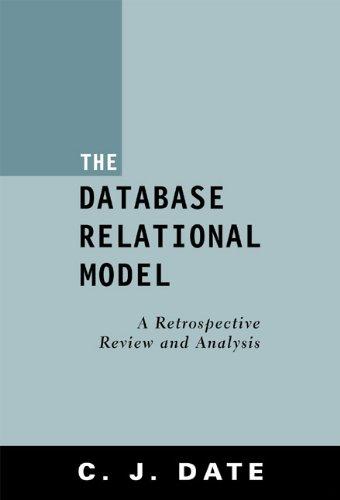Question
Can anyone answer this? 14.1 Modify the path.java program (Listing 14.2) to print a table of the minimum costs to get from any vertex to
Can anyone answer this?
14.1 Modify the path.java program (Listing 14.2) to print a table of the minimum costs to get from any vertex to any other vertex. This exercise will require some fiddling with routines that assume the starting vertex is always A.
LISTING 14.2 The path.java Program
// path.java
// demonstrates shortest path with weighted, directed graphs
// to run this program: C>java PathApp
class DistPar // distance and parent
{ // items stored in sPath array
public int distance; // distance from start to this vertex
public int parentVert; // current parent of this vertex
public DistPar(int pv, int d) // constructor
{
distance = d;
parentVert = pv;
}
} // end class DistPar
class Vertex
{
public char label; // label (e.g. A)
public boolean isInTree;
public Vertex(char lab) // constructor
{
label = lab;
isInTree = false;
}
} // end class Vertex
class Graph
{
private final int MAX_VERTS = 20;
The Shortest-Path Problem 703
private final int INFINITY = 1000000;
private Vertex vertexList[]; // list of vertices
private int adjMat[][]; // adjacency matrix
private int nVerts; // current number of vertices
private int nTree; // number of verts in tree
private DistPar sPath[]; // array for shortest-path data
private int currentVert; // current vertex
private int startToCurrent; // distance to currentVert
public Graph() // constructor
{
vertexList = new Vertex[MAX_VERTS];
// adjacency matrix
adjMat = new int[MAX_VERTS][MAX_VERTS];
nVerts = 0;
nTree = 0;
for(int j=0; j for(int k=0; k adjMat[j][k] = INFINITY; // to infinity sPath = new DistPar[MAX_VERTS]; // shortest paths } // end constructor public void addVertex(char lab) { vertexList[nVerts++] = new Vertex(lab); } public void addEdge(int start, int end, int weight) { adjMat[start][end] = weight; // (directed) } public void path() // find all shortest paths { int startTree = 0; // start at vertex 0 vertexList[startTree].isInTree = true; nTree = 1; // put it in tree // transfer row of distances from adjMat to sPath for(int j=0; j { int tempDist = adjMat[startTree][j]; sPath[j] = new DistPar(startTree, tempDist); } // until all vertices are in the tree while(nTree < nVerts) { int indexMin = getMin(); // get minimum from sPath int minDist = sPath[indexMin].distance; if(minDist == INFINITY) // if all infinite { // or in tree, System.out.println(There are unreachable vertices); break; // sPath is complete } else { // reset currentVert currentVert = indexMin; // to closest vert startToCurrent = sPath[indexMin].distance; // minimum distance from startTree is // to currentVert, and is startToCurrent } // put current vertex in tree vertexList[currentVert].isInTree = true; nTree++; adjust_sPath(); // update sPath[] array } // end while(nTree displayPaths(); // display sPath[] contents nTree = 0; // clear tree for(int j=0; j vertexList[j].isInTree = false; } // end path() public int getMin() // get entry from sPath { // with minimum distance int minDist = INFINITY; // assume minimum int indexMin = 0; for(int j=1; j { // if its in tree and if( !vertexList[j].isInTree && // smaller than old one sPath[j].distance < minDist ) { minDist = sPath[j].distance; indexMin = j; // update minimum } } // end for return indexMin; // return index of minimum } // end getMin() public void adjust_sPath() { // adjust values in shortest-path array sPath int column = 1; // skip starting vertex while(column < nVerts) // go across columns { // if this columns vertex already in tree, skip it if( vertexList[column].isInTree ) { column++; continue; } // calculate distance for one sPath entry // get edge from currentVert to column int currentToFringe = adjMat[currentVert][column]; // add distance from start int startToFringe = startToCurrent + currentToFringe; // get distance of current sPath entry int sPathDist = sPath[column].distance; // compare distance from start with sPath entry if(startToFringe < sPathDist) // if shorter, { // update sPath sPath[column].parentVert = currentVert; sPath[column].distance = startToFringe; } column++; } // end while(column < nVerts) } // end adjust_sPath() public void displayPaths() { for(int j=0; j { System.out.print(vertexList[j].label + =); // B= if(sPath[j].distance == INFINITY) System.out.print(inf); // inf else System.out.print(sPath[j].distance); // 50 char parent = vertexList[ sPath[j].parentVert ].label; System.out.print(( + parent + ) ); // (A) } System.out.println(); } } // end class Graph class PathApp { public static void main(String[] args) { Graph theGraph = new Graph(); theGraph.addVertex(A); // 0 (start) theGraph.addVertex(C); // 2 theGraph.addVertex(B); // 1 theGraph.addVertex(D); // 3 theGraph.addVertex(E); // 4 theGraph.addEdge(0, 1, 50); // AB 50 theGraph.addEdge(0, 3, 80); // AD 80 theGraph.addEdge(1, 2, 60); // BC 60 theGraph.addEdge(1, 3, 90); // BD 90 theGraph.addEdge(2, 4, 40); // CE 40 theGraph.addEdge(3, 2, 20); // DC 20 theGraph.addEdge(3, 4, 70); // DE 70 theGraph.addEdge(4, 1, 50); // EB 50 System.out.println(Shortest paths); theGraph.path(); // shortest paths System.out.println(); } // end main() } // end class PathApp
Step by Step Solution
There are 3 Steps involved in it
Step: 1

Get Instant Access to Expert-Tailored Solutions
See step-by-step solutions with expert insights and AI powered tools for academic success
Step: 2

Step: 3

Ace Your Homework with AI
Get the answers you need in no time with our AI-driven, step-by-step assistance
Get Started


